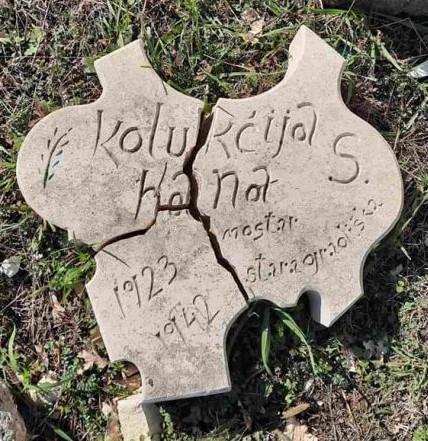
brochure "Partizanski spomenik u Mostaru" (1980)
book “Spomenica Mostara 1941-1945.”
another document or proof of the memorial stone (e.g., a photograph).
Hana S. KOLUKČIJA
HANA KOLUKČIJA, daughter of SELIM, born on March 6, 1923, in Mostar, a student at the Gymnasium, member of the League of Communist Youth (SKOJ) since 1941. Before joining the Battalion, she worked as an activist for the People’s Liberation Movement and an underground operative in Mostar. According to some sources, she infiltrated the Ustaše organization and engaged in espionage, leveraging the fact that the Ustaše youth leader Ico Omeragić was in love with her. Through her, the SKOJ learned about the existence of the illegal Ustaše organization called “Crna ruka” (Black Hand), which was initially formed at the Gymnasium and later developed branches in other high schools. Members of the “Crna ruka” were tasked with infiltrating SKOJ organizations and eliminating prominent SKOJ members. Hana (…) also provided information about planned house searches, raids, arrests of comrades, and unit rotations. When she faced the danger of being arrested for her infiltration activities, she joined the Battalion in July 1942. However, her time in the unit was short-lived as she was captured in Gračanica near Bugojno in August 1942. The County Prefect of the Independent State of Croatia (NDH), Dr. Kadić, informed the Ministry of the Croatian Home Guard that “Hana Kolukčija was caught as a partisan, although she had previously been a member of the Ustaše youth.” She was killed in the Stara Gradiška camp in 1942.
As remembered by a fellow fighters:
“A miller approached us and said that the Ustashas had captured a friend. According to the description, we knew that it was Hana Kolukčija. Hana belonged to a group of Mostar’s SKOJ youth. She was one school year younger than me, I think she attended high school class grade 6 at the time. She joined the partisans in July, when we retreated from Boračko Jezero. We all already knew her well. We were not allowed to carry out reprisals against the locals. For that, we had to ask for permission from the Battalion Headquarters. Then one of our fighters, I don’t know which one, rushed to the Headquarters on horseback and got permission to burn down the house of the Ustasha who captured Hana, which we did. Later, in 1943, I learned from Seka Ćemalović, who at that time lived in Breza, that she was with Hana Kolukčija in Jasenovac. She is a witness to Hana’s tragic death in Jasenovac, from where Seka managed to escape.”
“When we got to the end of the forest, we were surprised by the Ustasha who moved from Bugojno during the night and ambushed us. We saw that the enemy was significantly more numerous, so we started to retreat. While retreating, I ran into Hana Kolukčija . Somehow we were left alone. Hana’s leg hurt and she couldn’t run. I got separated from Hana in the run. I threw everything I had, except the rifle to make it easier. In the run I heard Hana scream, because they was overtaken and captured by the Ustasha (Hana Kolukčia was taken to a camp and killed after being captured).”
Former inmate Narcisa recalled “all the girls from Mostar,” but Hana Kolukčija stood out the most as they had attended elementary school together and were friends. They found themselves in the infamous camp. In the summer of 1942, Hana was imprisoned in the tower, and Narcisa encountered her in the courtyard. During their meeting, Hana told her that she was captured as a partisan. Narcisa was not pleased to see Hana in the notorious tower, where there were workshops such as a tailoring shop and a laundry room. The Ustaše would bring women to work in the tower, but when it became overcrowded, they would liquidate everyone and fill it anew. One evening, when the Ustaše were carrying out such a massacre, Hana perished.” She was remembered as a “beautiful and always cheerful girl.”
Hana’s name was recorded on a memorial plaque at the Mostar Gymnasium after the war. The plaque disappeared without a trace during the war events of 1992-1995.
Ćemalović, Enver (1986): Mostarski bataljon, Mostar; https://poskok.info/mostarke-u-doba-okupacije-sloboda-nije-stigla-iz-bajke/; ; http://www.most.ba/091/015.aspx; https://www.portalnovosti.com/mostarke-otpor-u-zicama ; grupa autora (1986): Hercegovina u NOB 4. dio, Beograd; Seferović, Mensur (1970): Pred očima grada, »Informativni centar Mostar«, 1970; nagrada »14. februar« Skupštine opštine Mostar, 1970; Seferović, Mensur: Mostarski kolopleti, edicija “Mostar u borbi za slobodu”, knjiga 8, Mostar; Seferović, Mensur (1981): „Istočno i zapadno od Neretve“, „Narodna armija“, Beograd; Alikalfić, Fazlija, Seferović, Nusret (1989): “Zbornik sjećanja o Mostarskom bataljonu”, Skupština opštine, Odbor za istoriju revolucionarnog radničkog pokreta i NOB-a Mostara; Holocaust Survivors and Victims Database — HANA KOLUKČIJA (ushmm.org); Miletić, Antun: “Koncentracioni logor Jasenovac 1941-1945. Dokumenta“, knj. I-II, 1986, knj. III, 1987, knj. IV, 2007, str. 2500, Narodna knjiga, Gambit, Belgrade, Jagodina; Most 180 (91) – Alija Bijavica: Kome smetaju spomenici; The Bosnian Muslims in the Second World War – Marko Attila Hoare – Google Books; Konjhodžić, Mahmud (1981): “Mostarke”: fragmenti o revolucionarnoj djelatnosti i patriotskoj opredjeljenosti žena Mostara, o njihovoj borbi za slobodu i socijalizam, Opštinski odbor SUBNOR-a Mostar; Drago Karlo Miletić, članak „Italijanska reokupacija Mostara (septembar 1941 – juni 1943), Hercegovina br 7; Halilbegović, Nihad (2006): Bošnjaci u jasenovačkom logoru, Sarajevo; The Bosnian Muslims in the Second World War – Marko Attila Hoare – Google Books; grupa autora: Spomenica Mostara 1941-1945. Fotografija: https://radiosarajevo.ba/vijesti/bosna-i-hercegovina/kome-vise-smeta-partizansko-groblje/407307#
Photo of the memorial plaque: S. Demirović (2018).
Do you have more information about this fighter? Share your stories and photographs. Let's keep the memory alive!




